Biochar Is Key to Cascading Benefits in Innovative Carbon Chicken Project
 Print This Post
Print This Post
Fifth-generation Arkansas farmer Jody Hardin was introduced to a potentially game-changing soil additive through a USDA Conservation Innovation Grant in 2011. That’s when Hardin began studying biochar—a charcoal-like material that can be mixed in soil to improve overall soil health.
“I had this huge, eye-opening experience,” Hardin said. “That’s when I started actually using biochar on my crops, doing workshops, and teaching farmers how to make it.”
Biochar is created by heating biomass, such as forest waste or animal manure, in a low-oxygen environment—a process known as pyrolysis. Carbon stored in this form can be added to soil to improve moisture retention, nutrient availability, and aeration and create habitat for beneficial soil microbes, all of which can potentially boost soil productivity. Biochar can also last for thousands of years in soil, so it’s increasingly being viewed as an effective means of sequestering carbon.
Now, Hardin wants to use the knowledge he’s gained to tackle some big challenges across the state by using biochar to clean up the Illinois River watershed, reduce greenhouse gas emissions, and help farmers improve the quality of their soil through his innovative initiative called the Carbon Chicken Project.
Many birds with one stone
The Carbon Chicken Project, which aims to develop a market-based, carbon-negative farming ecosystem, has taken shape in Northwest Arkansas, an area with a strong poultry production industry. In fact, the state of Arkansas ranks third in the country for the number of broilers produced (1 billion in 2022). Hardin’s plan is specifically designed to address three things: The first is runoff from poultry litter from the region’s many chicken houses that deposits excess phosphorus into the Illinois River watershed. The second is an abundance of forest and sawmill waste, which releases greenhouse gasses into the atmosphere if left to decompose. Third, Hardin and other farmers are seeking new ways to increase their yields by improving soil health.
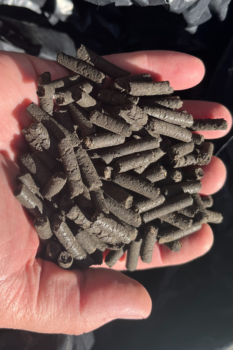 To contend with these issues, the project composts the poultry litter and combines it with biochar made from forest and sawmill waste and poultry litter. The result is a soil conditioner to help farmers build healthy soil and reduce the application of expensive fertilizers that can harm the Arkansas River watershed.
To contend with these issues, the project composts the poultry litter and combines it with biochar made from forest and sawmill waste and poultry litter. The result is a soil conditioner to help farmers build healthy soil and reduce the application of expensive fertilizers that can harm the Arkansas River watershed.
For many, this win-win-win solution would be enough. But for Hardin—an agricultural entrepreneur with an economics background—it’s a foundation for a larger vision.
“We’re trying to build this whole ecosystem around biochar that’s very extensive, but when you think about an ecosystem, it’s really a circular economy,” Hardin said. “We can sell the carbon credits, we can sell the biochar, and we can make electricity, and we can clean up a watershed, and we can sequester carbon and prevent climate change. It’s just cascading the benefits of what this product does.”
Accelerating biochar
Producers across the country are looking to Congress to realize biochar’s immense potential. With the most recent Farm Bill recently expired, the National Center for Appropriate Technology (NCAT) is asking Congress to invest in biochar research through the next Farm Bill, under the bipartisan Biochar Research Network Act. If passed, the bill will authorize the U.S. Department of Agriculture (USDA) to establish a national-scale research program to test different biochar types in different soils and circumstances. With better research will come innovation and practical tools for farmers, ranchers, foresters, and businesses to lean into biochar as a climate solution that improves their bottom line.
On the research front, a recent USDA study showed that biochar made from poultry litter adds value and could be an attractive solution for waste disposal for the industry.
Hardin knows the impact that investment in biochar research can make, referring to his own introduction to biochar—and subsequent learning, experimentation, and research—stemmed from a grant from Natural Resources Conservation Service (NRCS) Conservation Innovation Grants (CIG).
“The Carbon Chicken Project would have never ever happened if it wasn’t for this CIG grant,” Hardin said. “That innovation grant really worked because we’ve created this massive environmental solution for Northwest Arkansas’s watershed using a scaled-up idea that started with that little grant.”
Next steps
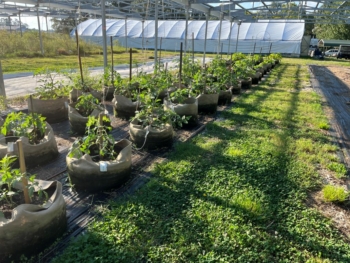 Right now, Hardin is working on securing project funding while creating an 11-acre carbon innovation and demonstration farm that can serve as a research facility for the Carbon Chicken Project—and to get other agricultural partners on board.
Right now, Hardin is working on securing project funding while creating an 11-acre carbon innovation and demonstration farm that can serve as a research facility for the Carbon Chicken Project—and to get other agricultural partners on board.
“I’ve been doing biochar research here on my farm for a good year, and I’ve got feedstock sources, I’m building pyrolysis units, I’ve got different application rate studies already going,” he said. “I’m trying to use this as a base to organize farmers so that they can see the amazing benefits and the yield increases, and all the things that we’re doing.”

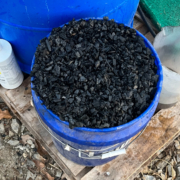

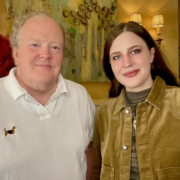
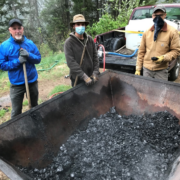 Courtesy
Courtesy
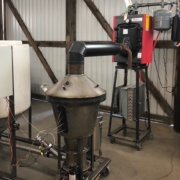
 Courtesy
Courtesy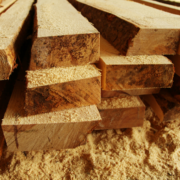
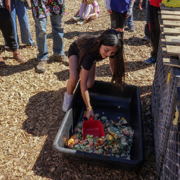
 Julian Fong Wiki Commons
Julian Fong Wiki Commons
